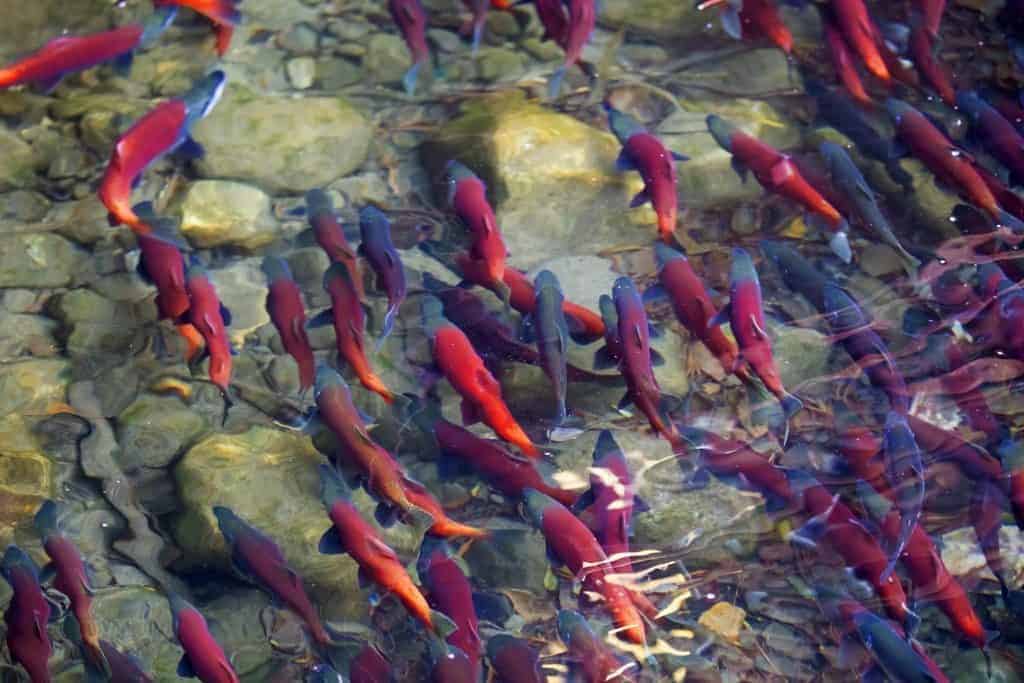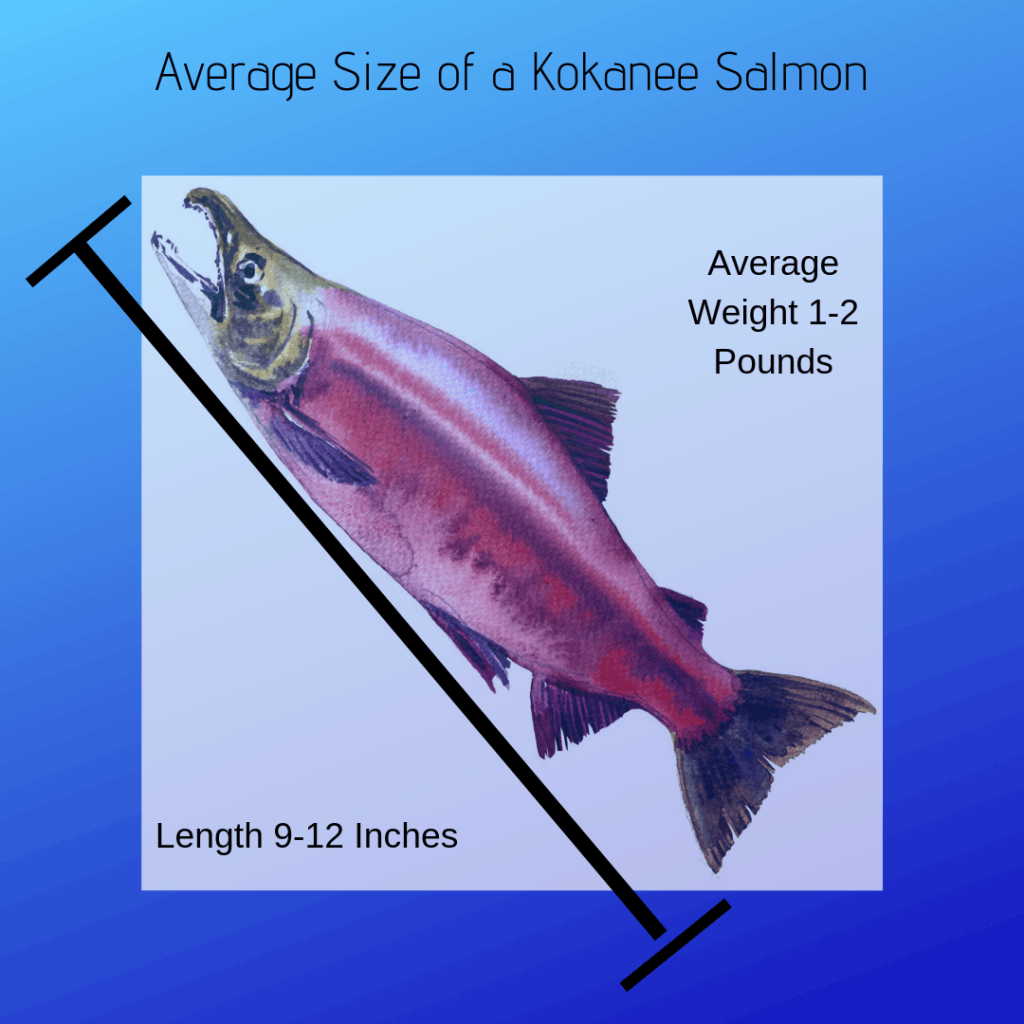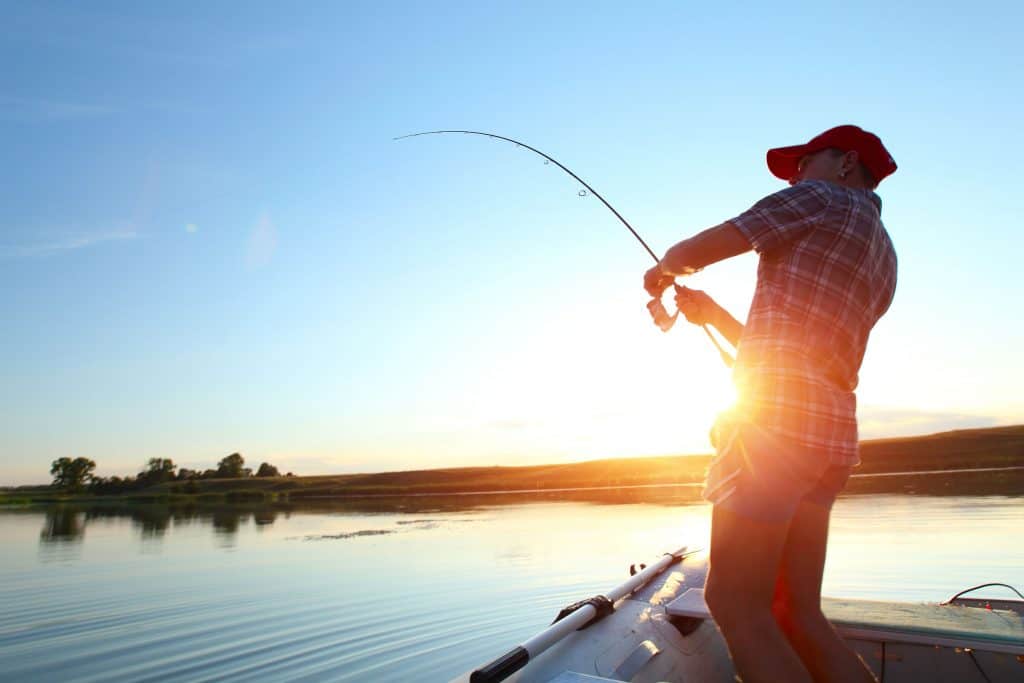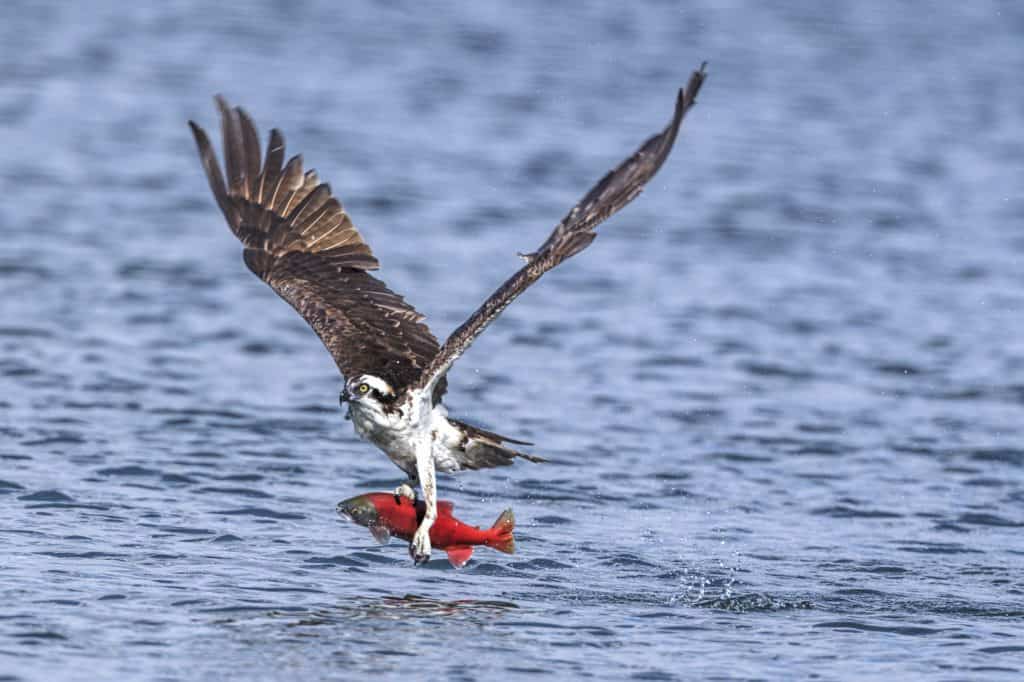
Telling a good fish story is the ultimate and legendary pastime when it comes to our classic image of fishermen. While a Kokanee salmon probably won’t be the biggest fish you’ll ever catch, knowing how these fish tick will give you the best chance to catch a “story worthy” fish of size.
Kokanee salmon will typically reach a length between 9 to 12 inches at adulthood and have an average weight of 1 pound. Length and weight will fluctuate based on their surroundings and environment. Kokanee Salmon don’t get much larger than 13 inches because they are landlocked.
So what do you need to know in order to get yourself the best and biggest Kokanee salmon?

Length
While the average length for a Kokanee salmon is 9 inches to 1 foot, the kokanee most certainly can (and does) get bigger. In 2010, the largest recorded Kokanee salmon was caught in Wallowa Lake located in Oregon, coming in at more than 27 inches long. Ron Campbell, the Pendleton native who landed the monster, claims to have previously glimpsed and battled an even bigger Kokanee salmon, one which he hoped to find again, assuming it survived the following winter.
“On the second jump, he broke my 10-pound test line. I got to see him twice and he was a monster.”
Campbell – World Record Holder
www.lagrandeobserver.com
Unfortunately for the average avid fisherman or woman, this is far above the average. Kokanee salmon will typically hit at least 10 inches after two years, and they generally spawn at 2 or 3, which generally signals the end of their lifespan.
In Yukon, Canada, the kokanee salmon of Kathleen Lake occasionally but rarely break 20 inches. At Anderson Ranch Resoviour in Idaho, the average size of a Kokanee salmon is being reported from 13 to 14 inches, with the average size in 2018 being 16.5 inches, according to Idaho’s official Fish and Game website.

Weight
So, how much did this world record Kokanee weigh? Coming in at 9 pounds, 10 ounces, this beast of a fish adds to its record another statistical anomaly, weighing almost 10 times the normal weight for a Kokanee salmon. Ron Campbell, the man who caught this world record fish, has previously tangled with an even bigger Kokanee, which he claims probably weighed around 12 pounds. With a typical Kokanee weighing 1 pound, catching a 2 pound Kokanee salmon is a treat, with a 5 pound fish being considered a trophy.
With such an obvious gap in possible length and weight, there are specific, measurable factors that can contribute to the size of the salmon in question.
Nutritional Availability
First we have nutritional availability. Kokanee salmon, like many other living things, will grow bigger if they eat more. Salmon in the ocean have a much higher availability of nutrients, which accounts for their much larger average size. Kokanee salmon are actually a type of sockeye salmon. Sockeye salmon have an average length of 32 inches, and a typical weight of around 9 pounds. The primary difference between these two salmon, aside from length and weight, are the places they call home.
Sockeye salmon have adapted to be able to transition from fresh water, to salt water, and back to fresh water again. Their time in the ocean provides them with a much larger presence of food, which enables them to eat far more than their freshwater relatives, causing them to grow much bigger in length and weight. Not only do Kokanee salmon lack this evolutionary advantage, many, if not most of them, are completely landlocked, constraining them to the nutrients available to them in their immediate surroundings.
With plankton being typically less plentiful in lakes and streams than they are in the ocean, the vast majority of Kokanee salmon simply aren’t able to consume enough to reach notable sizes.
Population Size
Another, slightly more aggravating factor in the measurements of Kokanee salmon, is the size of the population of their species of salmon where they live. If you didn’t put much thought into it, you may assume that “the more fish there are, the higher chance there is that I’ll score a big one!”, but that’s actually not the case.
Kokanee salmon eat plankton and other similar, very small organisms, filtering out the food through special plates in their gills, and they are one of the only fish in their location that feeds this way. Unfortunately, this means that these fish are all competing for an almost singular food source, and the more of the Kokanee there are, the less plankton there are per fish.
While this may increase your odds of catching a Kokanee, you’re sacrificing quality for quantity. There may be more of them, but because there are more, they are smaller. Smaller numbers of Kokanee in an area will increase the size of the fish, but unfortunately, you’ll be trading off. Essentially, the more fish there are, the smaller they are, but because there are more, your odds of catching one are higher.
The fewer Kokanee there are, the bigger they will be due to nutritional availability, but because there are less of them, they will be harder to find, and therefore, harder to catch.
Other Factors
There are a few other considerations that can be taken into determining the odds of catching a larger Kokanee salmon, but they’re less predictable, and out of your control. Scientists have speculated that larger salmon may be sterile, or infertile. Since the vast majority of salmon pass away after spawning, sterile or infertile salmon would continue to live, eat, and grow year after year, until they died of old age, or were eaten by a predator.

Predators are another, and somewhat more measurable factor that is in play. Kokanee salmon are a prey fish, and very near the bottom of the food chain. Because of this, they are eaten by a number of other fish, like rainbow trout and bull trout, as well as airborne predators like eagles and hawks. Bears are another predator that preys on the kokanee salmon, particularly during spawning seasons.
Fewer predators mean more salmon, which means there will be more competition for their food source, making them smaller on average. Adding more predators, unfortunately, also equates to fewer salmon, but this does increase the likelihood of the surviving Kokanee being on the larger side.
